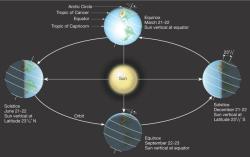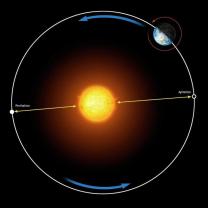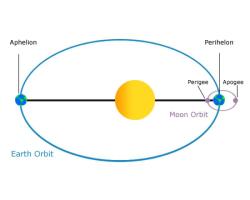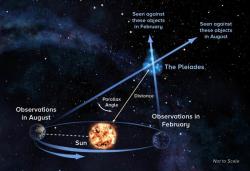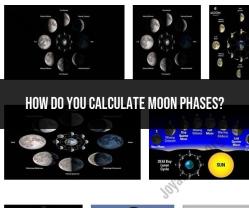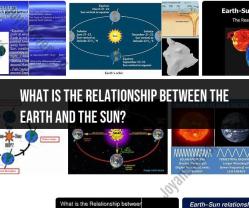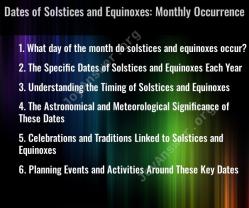When are the solstices and equinoxes each year?
The dates of the solstices and equinoxes are fixed points in the Earth's orbit around the Sun and occur at roughly the same time each year. However, they can vary by a day or two due to the Earth's elliptical orbit and other factors. Here are the approximate dates of the solstices and equinoxes each year:
Winter Solstice:
- Occurs around December 21st or 22nd in the Northern Hemisphere.
- Marks the shortest day and longest night of the year in the Northern Hemisphere.
Summer Solstice:
- Occurs around June 20th or 21st in the Northern Hemisphere.
- Marks the longest day and shortest night of the year in the Northern Hemisphere.
Vernal Equinox (Spring Equinox):
- Occurs around March 20th or 21st in the Northern Hemisphere.
- Marks the beginning of spring in the Northern Hemisphere.
- Day and night are approximately of equal length.
Autumnal Equinox (Fall Equinox):
- Occurs around September 22nd or 23rd in the Northern Hemisphere.
- Marks the beginning of fall in the Northern Hemisphere.
- Day and night are approximately of equal length.
For the Southern Hemisphere, the dates of the solstices and equinoxes are opposite those in the Northern Hemisphere:
- The Winter Solstice in the Southern Hemisphere occurs around June 20th or 21st.
- The Summer Solstice in the Southern Hemisphere occurs around December 21st or 22nd.
- The Vernal Equinox in the Southern Hemisphere occurs around September 22nd or 23rd.
- The Autumnal Equinox in the Southern Hemisphere occurs around March 20th or 21st.
Keep in mind that the specific dates can vary slightly each year, so it's a good idea to check an updated calendar or an astronomical almanac for the precise dates of these events for any given year.
Dates of Solstices and Equinoxes: An Annual Overview
The Earth's axis is tilted at an angle of 23.5 degrees, which causes the solstices and equinoxes to occur each year. The solstices are the two days of the year when the Sun is at its farthest north or south of the equator. The equinoxes are the two days of the year when the Sun is directly above the equator.
Here are the dates of the solstices and equinoxes in 2023:
- Vernal equinox: March 20
- Summer solstice: June 21
- Autumnal equinox: September 23
- Winter solstice: December 22
Explaining the Significance of Solstices and Equinoxes
The solstices and equinoxes have been significant to cultures around the world for centuries. They mark the changing of the seasons and the renewal of life.
The summer solstice is the longest day of the year and the winter solstice is the shortest day of the year. The autumnal equinox and vernal equinox are days when the day and night are of equal length.
How the Position of the Sun Affects Solstices and Equinoxes
The position of the Sun relative to the Earth is what causes the solstices and equinoxes to occur.
On the summer solstice, the Sun is at its farthest north in the sky for observers in the Northern Hemisphere. This means that the Northern Hemisphere receives the most sunlight on this day. On the winter solstice, the Sun is at its farthest south in the sky for observers in the Northern Hemisphere. This means that the Northern Hemisphere receives the least sunlight on this day.
On the autumnal equinox, the Sun is directly above the equator. This means that both the Northern and Southern Hemispheres receive equal amounts of sunlight on this day. On the vernal equinox, the Sun is directly above the equator. This means that both the Northern and Southern Hemispheres receive equal amounts of sunlight on this day.
Cultural and Scientific Celebrations of Solstices and Equinoxes
Many cultures around the world celebrate the solstices and equinoxes. Some of the most well-known celebrations include:
- Stonehenge: Stonehenge is a prehistoric monument in England that is aligned with the solstices. On the summer solstice, thousands of people gather at Stonehenge to watch the sunrise.
- Yule: Yule is a pagan holiday that celebrates the winter solstice. Yule is often celebrated with feasts, bonfires, and gift-giving.
- Litha: Litha is a pagan holiday that celebrates the summer solstice. Litha is often celebrated with bonfires, dancing, and feasting.
- Ostara: Ostara is a pagan holiday that celebrates the spring equinox. Ostara is often celebrated with egg hunts, flower crowns, and bonfires.
- Mabon: Mabon is a pagan holiday that celebrates the autumnal equinox. Mabon is often celebrated with harvest festivals, feasts, and thanksgiving.
In addition to cultural celebrations, the solstices and equinoxes are also important for scientific research. Scientists use the solstices and equinoxes to study the Earth's orbit around the Sun and the tilt of the Earth's axis.
Observing the Changing Seasons with Solstices and Equinoxes
The solstices and equinoxes are a great way to observe the changing seasons. You can notice the changes in the length of the day, the temperature, and the amount of sunlight that you receive.
You can also observe the changes in the plant and animal life around you. For example, you may notice that the leaves on the trees start to change color in the fall or that the birds start to migrate in the spring.
Conclusion
The solstices and equinoxes are significant events that mark the changing of the seasons. They are celebrated by cultures around the world and are important for scientific research. You can observe the changing seasons by paying attention to the length of the day, the temperature, the amount of sunlight, and the plant and animal life around you.


